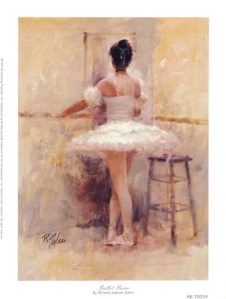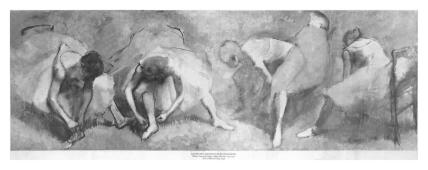This is a scene from the 2010 movie “Black Swan”. I think that this movie does a good job of showing the pressures of being a ballerina in a New York City ballet company. Much like the ballerinas of the 19th century they are competing for a status, the status of Prima Ballerina.
Latest Entries »
- Lichtner untitled 1984
- Lichtner mid 20th century
- Paolo Volarez-ballerina i
- Paolo Volarez~ballerina II
Lorissa Julianus is a modern artist from Chicago, IL. She has been creating portraits since 1998 and much like Degas is fascinated by the human form and its dramatic expressions, which would explain her choosing to paint ballerinas. She is a theatre professional and became a published playwright at the young age of 16. She also was the youngest graduate of record with a B.A. from Columbia College Chicago. She is now teaching at the Brigantine Gallery in downtown Downers Grove, IL. Starring in commercials, films, and video games. She is also a professional make-up artist and model. As you may be able to tell she has a huge love for the arts.
In the 19th century the theatre offered an opportunity for young women a chance to escape a life of poverty and misery. These young girls, with any luck, would be accepted into the Academic Royale, often making their stage performance at the young age of 14 or 15. Although a mediocre talented girl on stage may earn the same of a seamstress, this gave them a better chance to be seen by a wealthy gentleman. Patronage of ballerinas was a pleasurable diversion for these wealthy gentlemen from their everyday, often boring, life. The Paris Opera ballet’s back stage was the prestigious venue for sexual rendezvous and ballerinas were stigmatized by the blemish of “working-class origins and sexual impropriety.” (Ditmore)
“The connection between prostitution and ballet is true-to-life and born out of the 19th century ballet movement where the reality for young ballerinas coming from working-class families caused them to work and dance and sometimes be taken advantage of physically and financially.” (Ditmore) Female dancers were seen as the echelons of prostitution giving the term ballet girl a sexual connotation until the mid-twentieth century.
Ditmore, Melissa Hope. Encyclopedia of prostitution and sex work. Santa Barbara: Greenwood Publishing Group, 2006.
I tried finding the history and original meaning behind men giving ballerinas flower bouquets and although I couldn’t find the exact meaning I found some interesting information. I did find that the tradition of giving flowers to performers dates back to the Middle Ages. According to http://www.dance-studio-roses.com it was believed that giving flowers to the actors brought good luck to the entire production.
With this thought about bringing good luck there also comes superstitions about bad luck. In an article on http://www.ehow.com by Siva Stephens, she states that it is very bad luck to receive flowers at the stage door before a performace but very good luck to get them after the final curtain call.
The custom of giving flowers seems to vary across the globe. According to http://www.humanflowerproject.com in the U.S. it’s nearly taboo to present a bouquet to a male dancer, whereas abroad both male and female performers are flowerable. In all countries though it seems customary, upon retirement to present dancers with floral bouquets to commemorate their stellar careers.
I even found information on flowers specific meanings. Red roses convey admiration, energy and strength, whereas pink roses are thought to be more appropriate for young girls. Elton Dunn of http://www.ehow.com suggests giving yellow or pink roses to a friend or family member and saving the red for a romantic partner. Carnations are said to symbolize beauty and pride, Irises symbolize compliments and tulips tell a dancer you cherish her and her dancing and are said to be good for young aspiring dancers.
No matter the type of flower, the tradition continues of giving bouquets after a performance to a dancer to show admiration and praise.
 Julie Kent is a Principle Dancer for the American Ballet Theatre. The American Ballet Theatre was launched in 1939 and is one of the most highly regarded ballet companies today. Kent became a soloist for the company in 1990 and a Principle Dancer in 1993. Before joining ABT as an apprentice in 1995 she began her dance training at the Academy of the Maryland Youth Ballet. In 1986, she was the only American to win a medal at the Prix de Lausanne International Ballet Competition and in 2000 she won the Prix Benois de la Danse.
Julie Kent is a Principle Dancer for the American Ballet Theatre. The American Ballet Theatre was launched in 1939 and is one of the most highly regarded ballet companies today. Kent became a soloist for the company in 1990 and a Principle Dancer in 1993. Before joining ABT as an apprentice in 1995 she began her dance training at the Academy of the Maryland Youth Ballet. In 1986, she was the only American to win a medal at the Prix de Lausanne International Ballet Competition and in 2000 she won the Prix Benois de la Danse.
Even as highly regarded as Principle Dancers are in this century, beauty still plays a large part. Georgina Parkinson of ABT recalls her first impression of Kent, “I was struck by her physical beauty. And just that, because she wasn’t strong, she had no confidence, but she worked very hard.”
 Richard Judson Zolan (1931-2001)- was an American Impressionist born in Chicago, IL and graduated from the Art Institue of Chicago, he later studied at Art Students League in New York City. He was a student of Louis Rittman, a personal friend, instructor and who was a student of Monet. Rittman taught Zolan the fundamental techniques and style of impressionism. The painting on the left is called Reflective Moment. The painting on the right is Ballerina at the Barre.
Richard Judson Zolan (1931-2001)- was an American Impressionist born in Chicago, IL and graduated from the Art Institue of Chicago, he later studied at Art Students League in New York City. He was a student of Louis Rittman, a personal friend, instructor and who was a student of Monet. Rittman taught Zolan the fundamental techniques and style of impressionism. The painting on the left is called Reflective Moment. The painting on the right is Ballerina at the Barre.
 http://www.allposters.com/-st/Richard-Judson-Zolan-Posters_c29568_.htm
http://www.allposters.com/-st/Richard-Judson-Zolan-Posters_c29568_.htm
 This sculpture is called Spanish Dancer, bronze number 45/A, it was cast in 1920 from a wax sculpture. The sculpture was first cast in plaster by the founder of the bronzes, Adrien Hebard, about 1900-1903. This sculpture is one in a series of three. The second sculpture is called Spanish Dance and the third, Dancer with Tambourine. This sculpture is one of the few that Degas allowed to be cast into a medium that is more durable than wax or clay.
This sculpture is called Spanish Dancer, bronze number 45/A, it was cast in 1920 from a wax sculpture. The sculpture was first cast in plaster by the founder of the bronzes, Adrien Hebard, about 1900-1903. This sculpture is one in a series of three. The second sculpture is called Spanish Dance and the third, Dancer with Tambourine. This sculpture is one of the few that Degas allowed to be cast into a medium that is more durable than wax or clay.
“Edgar Degas: Spanish Dancer (29.100.395)”. In Heilbrunn Timeline of Art History. New York: The Metropolitan Museum of Art, 2000–. http://www.metmuseum.org/toah/works-of-art/29.100.395 (October 2006)
 After Degas death in 1917 there were more than 150 sculptures found in his studio. Most were made of wax and clay but in 1918 Degas heirs decided to let 72 pieces to be cast in bronze. The bronzes were first put on exhibition in Paris, 1921 and assigned a number except The Little Fourteen-Year-Old Dancer. Each series of casts were also designated a letter (A-T). Like the one shown here, the Dancer Looking at the Side of Her Right Foot (29.100.377) was given the number 40 in the series and the letter A. This series of bronzes was completed before May 1921 when it was exhibited in Paris.
After Degas death in 1917 there were more than 150 sculptures found in his studio. Most were made of wax and clay but in 1918 Degas heirs decided to let 72 pieces to be cast in bronze. The bronzes were first put on exhibition in Paris, 1921 and assigned a number except The Little Fourteen-Year-Old Dancer. Each series of casts were also designated a letter (A-T). Like the one shown here, the Dancer Looking at the Side of Her Right Foot (29.100.377) was given the number 40 in the series and the letter A. This series of bronzes was completed before May 1921 when it was exhibited in Paris.








